Are you a Quiet Speculation member?
If not, now is a perfect time to join up! Our powerful tools, breaking-news analysis, and exclusive Discord channel will make sure you stay up to date and ahead of the curve.
With all of Core 2020 spoiled and the prerelease looming, it's time to wrap up spoiler talk. After the flood of clear playables in Modern Horizons, 2020 is back to being mostly about roleplayers and brewing opportunities. This is typical of a non-Modern-specific release, and much like a typical set, 2020 has plenty of interesting cards that need a home to make it in Modern.

I'd be remiss not to mention the results from this weekend's events. StarCityGames had a team Modern open in Baltimore, and GP Dallas was Modern. In both events, Hogaak, Arisen Necropolis-based combo decks were a huge presence. Hogaak was by far the most-played deck in Dallas, though Izzet Phoenix eclipsed it in Baltimore. What this means is hard to say. Baltimore being a team event necessarily caused distortions in the data from teams avoiding overlapping decks. Dallas's results are likely more valid, as the MCQ results look similar.
However, I wouldn't look to either event for direction on the metagame. Core 2020 releases next week, bringing not only new cards and a shift in the metagame, but also the London mulligan. All that change obsoletes the current data and may redefine Modern. I'd load up on graveyard hate as a precaution, but how powerful the Hogaak deck will actually end up is not clear. I don't want to speculate on metagame changes yet, so instead I'll speculate on the new cards.
Lotus Field
First up, we have the fixed and upgraded version of Lotus Vale. If you've never heard of Veil, I don't blame you. It never really had tournament success thanks to existing across from Wasteland for its entire history. However, it became notable after the 6th Edition rules changes turned it into Black Lotus. Before then, you had to sacrifice two untapped lands before Vale could be used; afterwards, the sacrifice became a triggered ability, and for a brief window Vale was Lotus. Wizards then errated Vale back to original functionality.
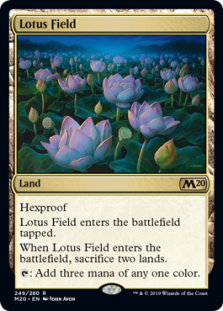 Field fixes most of the problems with Vale. It has hexproof to protect against Wasteland, enters play tapped, and requires two sacrifices even if you don't want it to stay in play. By itself, this is nowhere near playable in Modern, and probably not in Standard either (too much tempo loss). However, in conjunction with Amulet of Vigor, Field is potentially absurd. Two Amulets and a Field yield a turn-two Primeval Titan.
Field fixes most of the problems with Vale. It has hexproof to protect against Wasteland, enters play tapped, and requires two sacrifices even if you don't want it to stay in play. By itself, this is nowhere near playable in Modern, and probably not in Standard either (too much tempo loss). However, in conjunction with Amulet of Vigor, Field is potentially absurd. Two Amulets and a Field yield a turn-two Primeval Titan.
Granted, that's not very likely to happen (especially since I can't envision Field as more than a one-of), but a more plausible use is to play Titan as normally as possible for Amulet decks, then fetch Field to help power out a combo turn. I don't know how good that actually is, but Amulet players I know think it's worth testing. Be on the lookout.
Searching Further Afield
I've also heard rumors of using Twiddle effects with Field to generate large amounts of mana. Exactly how to get such an engine going, what it would be building to, or why it would need Field to operate is not clear to me,  but generating large amounts of mana is nothing to sneeze at. The main problem I foresee is that such a deck would be very vulnerable to disruption. Humans is very strong against decks of this style, and it seems like a single counter on a Twiddle could upend a potential combo turn.
but generating large amounts of mana is nothing to sneeze at. The main problem I foresee is that such a deck would be very vulnerable to disruption. Humans is very strong against decks of this style, and it seems like a single counter on a Twiddle could upend a potential combo turn.
Another possibility is alongside Blood Moon and Blood Sun. Either card will prevent Field from entering tapped and requiring sacrifice. The former would then need to be removed for Field to be broken, but the latter makes Field arguably the most powerful land legal in Modern. Each approach presents its own hoops to jump through. For the Moon route, there's the issues with taking it off the field and freeing opposing lands. With Sun, there's the fact that Sun itself isn't very good in Modern. Again though, having a huge mana boost may be all that's necessary.
Scheming Symmetry
Next up, there's the nerfed Vampiric Tutor. Vamp was a deceptively powerful card before it was banned everywhere. Instant speed tutoring is very good in the first place, and Vamp tutored for anything. The only restriction is that the tutored-for card went on top of the library instead of the hand, but that was solved by playing it on the opponent's endstep. I guarantee that if Vamp was legal, every deck would play a full set.
Enforced Symmetry
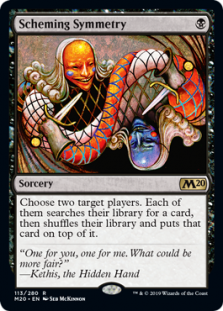 However, Scheming Symmetry is nowhere close to its predecessor. Wizards has nerfed the effect by first making Symmetry sorcery speed, and also by making it symmetrical. Playing Symmetry as-designed ensures that the opponent gets their card first, which is a great deal for them.
However, Scheming Symmetry is nowhere close to its predecessor. Wizards has nerfed the effect by first making Symmetry sorcery speed, and also by making it symmetrical. Playing Symmetry as-designed ensures that the opponent gets their card first, which is a great deal for them.
Also worth noting, Symmetry requires two target players. This means it cannot be cast if opponents have Leyline of Sanctity out. If they gain hexproof after Symmetry is cast, then their part fizzles while you still get to search. Spells that require multiple targets need the required targets to be cast, but only one to resolve.
Breaking Symmetry
If Symmetry is going to see Modern play, the Symmetry must be broken. There's no way to give opponents hexproof or shroud, so a different angle must be found. The obvious way that leaves is to mill away your opponent's card, and I expect that mill decks will employ of Symmetry as a result.
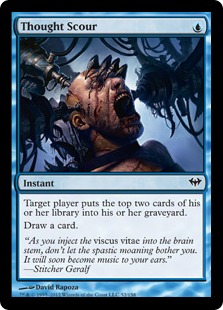 For other decks, Thought Scour is the most efficient way to break the symmetry. It's not only the cheapest, but it also draws the card you searched for. The main problem is that accomplishing this requires you to have Scour after tutoring. This means you didn't use it earlier, and that's not great. Also, not Scouring yourself is usually just wrong.
For other decks, Thought Scour is the most efficient way to break the symmetry. It's not only the cheapest, but it also draws the card you searched for. The main problem is that accomplishing this requires you to have Scour after tutoring. This means you didn't use it earlier, and that's not great. Also, not Scouring yourself is usually just wrong.
Using War of the Spark planeswalkers is another option, though I'm skeptical. Teferi, Time Raveler lets you Symmetry on the opponent's end step so you can draw your card first. Teferi is a good card, but this method takes setup and won't happen quickly. The opponent will also still get their card on their draw step.
 Ashiok, Dream Render is another option. It doesn't stop the opponent searching since they don't control Symmetry, but you can tutor then mill away the opposing found card. The only problem is that Ashiok doesn't see much play right now.
Ashiok, Dream Render is another option. It doesn't stop the opponent searching since they don't control Symmetry, but you can tutor then mill away the opposing found card. The only problem is that Ashiok doesn't see much play right now.
Regardless of how Symmetry gets broken, there's not currently a deck that wants to put that much effort into tutoring. Death's Shadow decks run Scour, but since they're adopting Ranger-Captain of Eos, they don't need Symmetry. Tutoring is also always better in a combo deck, though the only one that I know of that could use Symmetry is Ad Nauseam. It's not clear that Symmetry is better than Spoils of the Vault there.
It's also possible that decks don't bother trying to actually break Symmetry and just play it normally. I could see a Dredge-type deck just finding whatever they want to dredge away the following turn and not caring about what the opponent finds. I expect this to only work game 1, but that may be enough.
New Leylines
A big headline for 2020 is the return of leylines. Leyline of the Void and Leyline of Sanctity are getting welcome and much needed reprints (sidenote: Void's reprinting makes me wonder what Wizards knew about Hogaak's impact on Modern). Blue also got Leyline of Anticipation, but that card has never done anything in Modern, and I doubt that will change anytime soon.
Meanwhile, red and green got entirely new leylines, which have the potential to make it in Modern. The red leyline is very narrow, but its effect is incredibly powerful in the right matchup and in the right deck. Meanwhile the green leyline is potentially busted. It may be superfluous a lot of the time, but there are times that it will win the game.
Leyline of Combustion
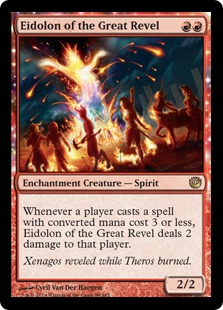 Red decks generally only interact with other decks via direct damage. This means that red decks have traditionally struggled against combo decks. Pyrostatic Pillar and then Eidolon of the Great Revel changed this somewhat by limiting how many spells the combo decks could cast before dying.
Red decks generally only interact with other decks via direct damage. This means that red decks have traditionally struggled against combo decks. Pyrostatic Pillar and then Eidolon of the Great Revel changed this somewhat by limiting how many spells the combo decks could cast before dying.
Leyline of Combustion follows in their footsteps, but rather than punishing casting spells, it punishes the win condition; a lethal Grapeshot against an opponent with Combustion out kills its caster instead. This doesn't stop the combo, just the kill, so its utility will be limited.
 Combustion does have additional value since it triggers if creatures are targeted. This could be decent for a Goblins deck against midrange or control, but I suspect they'll just start leaning more heavily on sweepers and moot Combustion. Alternatively, they could just take some damage, remove Combustion first and then start killing creatures, so I wouldn't look to Combusting any prepared opponent out of the game.
Combustion does have additional value since it triggers if creatures are targeted. This could be decent for a Goblins deck against midrange or control, but I suspect they'll just start leaning more heavily on sweepers and moot Combustion. Alternatively, they could just take some damage, remove Combustion first and then start killing creatures, so I wouldn't look to Combusting any prepared opponent out of the game.
Interestingly, this card may be best against Burn. Burn does a decent chunk of damage to itself off its lands, so if they're creature-light, Combustion may kill the Burn player first. I think I'd rather rely on Sanctity against burn since Lightning Helix is a card, but for those decks that can't run Sanctity, Combustion may be almost as good.
Leyline of Abundance
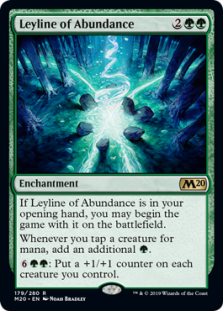 The green leyline requires some clarification: its ability affects only those abilities that have the tap symbol in them, so it doesn't work with Heritage Druid. However, Devoted Druid does tap for two mana. Thus, in the right context, Vizier of Remedies is no longer necessary for Druid to generate infinite mana. One Druid, Abundance, an untapped land, and Ezuri, Renegade Leader combine to make every elf arbitrarily large.
The green leyline requires some clarification: its ability affects only those abilities that have the tap symbol in them, so it doesn't work with Heritage Druid. However, Devoted Druid does tap for two mana. Thus, in the right context, Vizier of Remedies is no longer necessary for Druid to generate infinite mana. One Druid, Abundance, an untapped land, and Ezuri, Renegade Leader combine to make every elf arbitrarily large.
There's also the chance that Abundance is all that's needed to win. A board of mana dorks but no payoff is often death for Elves, but Abundance can fix that since it contains a means to pump the team. Working with Devoted Druid again, there's the potential to grow everything to considerable size very quickly. I don't know that this route is actually better than the current options, but it is worth looking into.
Season of Growth
On the subject of green enchantments, Season of Growth looks promising. The first ability is nothing to write home about, but the second might be just what fringe enhantment strategies need to be viable. Season turns every spell you cast on your own creatures into a cantrip. There's combo potential in Jeskai Ascendancy combo and its Crimson Wisps, but I think that boosting auras is the real intention here.
Bogles
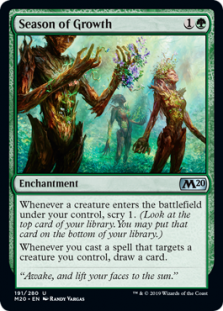 The big problem with Season is that it doesn't do anything worthwhile without creatures to target, making preemptive removal its worst enemy. As such, I think Season has potential in Bogles. Opponents can't preemptively remove hexproof creatures and Bogles tends to struggle with running out of gas.
The big problem with Season is that it doesn't do anything worthwhile without creatures to target, making preemptive removal its worst enemy. As such, I think Season has potential in Bogles. Opponents can't preemptively remove hexproof creatures and Bogles tends to struggle with running out of gas.
Kor Spiritdancer is already played primarily for this exact purpose, and I think Season challenges it well. Season is less vulnerable and also boosts Ethereal Armor. Spiritdancer being a target for auras is very important since Bogles' greatest weakness is the low creature count, but that's a backup plan most of the time. On balance, I think Season comes out ahead. The real question is whether that's enough to make Bogles an attractive option again.
Enchantress
The other thing worth noting is that Season is the closest thing Modern has to Enchantress's Presence which is a keystone in Legacy Enchantress. That deck is a prison deck built around Elephant Grass and Serra's Sanctum, neither of which is Modern legal. Modern does have its share of interesting prison enchantments and enchantress's, so there might be something to Season there. Of course, Season would only trigger on auras, so it will never be Presence, but it's looking increasingly plausible that Enchantress could be viable in Modern too.
Kykar, Wind's Fury
 The final card is a combo piece. Kykar, Wind's Fury makes the most sense in Jeskai Ascendancy as a backup plan in case Ascendancy gets hit by Surgical Extraction-style effects or called with Meddling Mage. Instead of outright winning, Kykar floods the board with fliers, which may be enough. If Kykar is out during the combo, he may help feed the combo by turning the spirits into red mana. How useful said mana might be is another question, but there's plenty of potential here.
The final card is a combo piece. Kykar, Wind's Fury makes the most sense in Jeskai Ascendancy as a backup plan in case Ascendancy gets hit by Surgical Extraction-style effects or called with Meddling Mage. Instead of outright winning, Kykar floods the board with fliers, which may be enough. If Kykar is out during the combo, he may help feed the combo by turning the spirits into red mana. How useful said mana might be is another question, but there's plenty of potential here.
Storm's Brewing
The big question hanging over 2020 is the London mulligan. The spoiled cards may rise or fall in value based more on how the new mulligan affects decks rather than their own merits. Nobody knows what that will do to Modern. Perhaps the doomsayers are right and broken combo decks will reign. Maybe Wizards and the optimists are right and it will have a positive impact. We'll have to wait for the data to come in to see.




Scheming Symmetry is the nerfed Imperial Seal, or double nerfed Vampiric Tutor, to be a pedant about it.